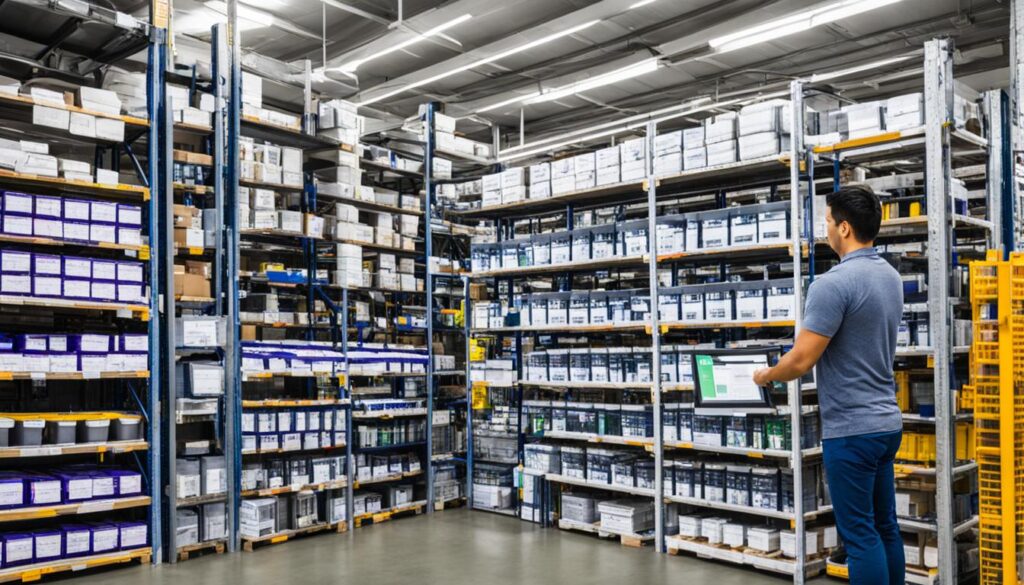Are you finding it hard to keep the right amount of stock for customers and not hold too much? The secret to running your business well is keeping the perfect inventory level. This way, you cut costs, make customers happier, and run your business more smoothly.
This article will take you into the details of managing your inventory. We’ll look at different approaches and tools that can help. It doesn’t matter if you own a small business or have been in the game for a while. Knowing how inventory affects your business’s success is crucial.
Understanding Inventory Management and Its Impact on Efficiency
Good inventory management lets businesses run better and more efficiently. It does this by using strong systems and tools. With these, tracking and controlling what a business has in stock becomes easier. This means you can have the right amount of products available when customers want them.
Defining Inventory Management Systems
Inventory management systems are the ways businesses keep track of their stock. They help keep stock in check in real time. This way, businesses can avoid running out of products or having too much. Both can cost a lot of money but for different reasons.
These systems use new tech like barcodes, RFID tags, and online tools. They make keeping track of items fast and accurate. Plus, they can work with other parts of a business, like sales and buying, easily.
The Correlation Between Inventory Levels and Operational Efficiency
How much inventory a business has directly affects how well it runs. Having too much can be bad because it costs money to store products and they might go bad. But, not having enough can also be a problem. If customers can’t get what they want, they might go somewhere else.
So, getting inventory levels just right is key to running a business well. This keeps costs low and customers happy. It makes sure products are available when they are needed and keeps money from getting tied up in storage costs.
Adopting Automated Tools for Enhanced Inventory Tracking
Automatic inventory tools are a big help. They mean businesses don’t need to track stock by hand. Instead, they can see what they have right away. This helps them make smarter choices based on real facts.
These tools can guess what customers will want next and make sure stock levels are good. They stop products from running out or piling up. This means less chance of losing money on stock that’s no longer needed. Plus, they help a business to understand what sells well, and what doesn’t, to make better choices about what to buy and how much to charge.
Using these tools means a business can be more accurate and efficient. They update instantly, fit in with other business parts, and help make smart decisions thanks to the data they provide.
In the next part, we’ll talk about what can go wrong with too much or too little inventory. We’ll see why it’s a big deal to manage stock well.
The Perils of Overstocking and Understocking
Finding the right inventory balance is crucial. Too much or too little stock can hurt a business. This can lower efficiency and profits. Let’s look at the dangers of too much stock and not enough stock.
Capital Locked in Excess Inventory
Having more stock than needed is overstocking. It seems smart to always have products ready for customers. But, it means spending lots of money that could go toward improving the business.
This extra stock costs money to store, loses value over time, and can even go unsold. All this cuts into a business’s profits.
Risks and Costs Associated with Overstocking
Putting too much money into stock has its drawbacks. It can raise warehouse costs and risks of damage or loss. Items can also become outdated, especially in fast-changing industries.
Customer Dissatisfaction Due to Frequent Stockouts
Not having enough stock is understocking. This leads to products running out. When this happens, customers get upset and might go to other businesses. This can result in lost sales and a worse reputation.
Strategies for Mitigating Overstocking and Understocking
There are ways to avoid both overstocking and understocking. Businesses can:
- Use forecasting to know what customers will want.
- Use software to track and order stock.
- Keep in touch with suppliers for timely restocks.
- Change stock levels based on market and customer trends.
- Work closely across teams to match stock with demand.
By managing stock well and staying alert to the market, businesses can avoid the dangers of over or understocking. This leads to better operations and happier customers.
Strategies for Optimizing Inventory Levels
Today, keeping the right amount of inventory is key to success. Businesses need strategies to meet customer needs without overstocking. We’ll look at using ERP systems, automating processes, and forecasting with real-time data.
Implementing ERP Systems for Holistic Management
ERP systems bring together many business functions, like inventory management, in one place. This gives a full view of inventory through the supply chain. Businesses can then track stock, see movement, and set reorder points with current data. This better view and control helps in smart decision-making about inventory, leading to more efficient turnover.

Automating Processes to Minimize Errors and Waste
Moving away from manual ways in managing inventory saves time and decreases mistakes. Businesses today use automation for tasks such as tracking orders and handling stock. By automating, they can adjust inventory levels to what customers really need, when they need it.
This shift cuts down errors and costs, making customers happier.
Using Real-Time Data for Accurate Demand Forecasting
Getting demand predictions right is crucial for managing inventory. Businesses use up-to-the-minute data to understand what customers want. This allows them to forecast trends, prepare for changes, and keep just enough stock on hand. It’s a proactive way to avoid running out of items and to keep customers happy.
Using real-time data also helps in making smarter purchasing choices, lowering expenses, and managing money better.
By using these three strategies, companies can keep their inventory levels just right and be more efficient. This not only saves money and trouble but helps them respond to customers quickly. This gives them an edge over competitors.
Integrating Technology: The Key to Modern Inventory Control
Today’s business world moves fast, making inventory control key for success. Technology is crucial here. It helps businesses manage their stocks better, improve efficiency, and operate smoothly.
Thanks to advanced software and tools, companies see their inventory status in real time. They can track their products accurately and use facts to make smart choices. This means no more manual mistakes and an all-in-one place for watching stock in various spots.
By using tech in inventory, businesses can predict what people will buy accurately. This leads to better filling of orders and fewer times when items are out of stock. They also get to know what consumers want and what’s hot in the market in no time. It’s all about staying at the top of inventory and the game.
Also, today’s inventory management systems come with great stuff like barcode scans, RFID tags, and cloud storage for info. This makes keeping track of stocks easy and error-free.
Having tech in how we manage stocks not only makes things run better but keeps customers happier. Companies can now promise and deliver on time, avoiding any letdowns from empty shelves or slow deliveries.
To sum up, technology is vital in the inventory game. Using tech well helps companies be smarter, run their show better, and please their customers. It’s a must for those who want to do well in the fast-changing market today.
Case Studies: Successful Inventory Level Optimization
Real-life case studies show us how businesses can make their inventory level optimization work. They teach us what strategies and actions boost efficiency and profit. This knowledge is invaluable for anyone in the business world.
Philippine SMEs Achieving Efficiency Through Better Inventory Management
Philippine SMEs have found that managing inventory well is key to using resources fully and satisfying customers. By putting in place the right systems, these smaller companies have cut costs, run more smoothly, and kept shoppers happy.
For instance, a local clothing shop used high-tech ERP software to better watch over its stock. This let them track sales, forecast what they’d need, and manage orders. Such moves made their cash flow better, their sales go up, and their service to customers improve.
How Implementing ERP Software Transformed Local Businesses
For local businesses, getting ERP software was a big deal in controlling stock and working more efficiently. This software brings together different parts of a business, like making sales, buying goods, and making things, into one system. Then, the whole team can see what’s happening with their stock, what they need, and how things are moving.
Imagine a little factory that got ERP software. It helped them keep an eye on stock in several places, improved how they planned their work, and made it easier to fill orders on time. This led to fewer times when they ran out of stock, lower costs for holding on to stock, and happier customers. Making decisions based on real data and quickly responding to what customers wanted became easier after using this software.
International Examples of Inventory Control Excellence
Looking around the world, there are many international examples of great stock management. These stories show how getting inventory levels just right makes a big difference.
A big online seller, known worldwide, shows this. They use smart programs and past info to guess what people will want. By doing this, they hardly ever run out of things to sell or have too much lying around. This makes customers happy, saves money, and makes the whole business run better.
Then, there’s a well-known maker of everyday items. They set up a smart system that watches stock in every warehouse and sends stuff where it’s needed without a person needing to find out. This made sure they knew exactly what they had, cut down on running out of goods, and made more money.

| Company | Inventory Optimization Strategy | Results |
|---|---|---|
| Local Clothing Retailer | Implementing ERP software for automated inventory tracking, demand forecasting, and order management | Improved cash flow, increased sales, minimized stockouts, and reduced excess inventory costs |
| Small Manufacturing Firm | Implementing ERP software for centralized inventory tracking, optimized production schedules, and streamlined order fulfillment | Significant reduction in stockouts, minimized inventory carrying costs, and improved customer satisfaction |
| Global E-commerce Giant | Utilizing advanced inventory management algorithms and predictive analytics | Accurate demand forecasting, avoidance of stockouts, and minimized excess inventory |
| Multinational Consumer Goods Company | Developing an integrated inventory management system leveraging advanced technologies | High inventory accuracy, reduced stockouts, and improved profitability |
Inventory Analysis: Unlocking the Potential of Data-Driven Insights
Inventory analysis is key for companies looking to keep their shelves just right. By digging into the numbers, businesses learn a lot about what they have on hand. They can see market trends clearly and make smart choices.
When a company looks into its inventory, it checks out a lot of info. This includes past sales, what customers want, and how long it takes to get items in. By studying this, they see where they can get better at handling stock.
The perks of this kind of analysis are big. It lets businesses do several things well:
- Optimize stock levels: Spotting trends in what’s selling helps keeps shelves stocked just right. This way, they don’t have too much or too little of anything, which makes everything run smoother.
- Identify slow-moving items: They can also find items that aren’t moving fast enough. By tackling this early, they can clear up space and cut costs.
- Improve order fulfillment: Understanding what customers will want helps fill orders better. This means fewer times they run out of something, keeping customers happy and the business efficient.
To really benefit from this, companies need to use the latest tools. Advanced inventory software is a big help. It crunches the numbers for them, giving up-to-the-minute insights. With these insights, businesses can do even better. They can make their stock work harder and their operations smoother.
| Benefits of Inventory Analysis |
|---|
| Optimize stock levels |
| Identify slow-moving items |
| Improve order fulfillment |
Inventory Visibility: Why Seeing the Full Picture Matters
It’s key to see how much inventory you have for good stock management. Companies need to know what’s in stock in various locations for smooth operations. This way, they can meet order requests better and not have too much or too little stock.

Centralizing Inventory Data Across Multiple Warehouses
With stores in many places, managing stock can be hard. But, gathering inventory data into one system helps. It gives a clear, combined view. Doing this improves how decisions are made, which can save money and work better.
The Role of Mobile Technologies in Real-Time Updates
Phones and tablets are now key in keeping up with stock by the minute. Warehouse teams can see stock info right away, no matter where they are. This means they can make fast choices, order more items when needed quickly, and respond to customers better.
Improving Order Fulfillment with Enhanced Visibility
Knowing stock levels well results in better order handling. This tells companies where their items are and if they’re available right now. So, they can complete orders faster and more accurately. This cuts down how long customers wait, lessens items running out, and makes customers happier. Also, using data in one place lets them see what customers like more. So, they do a better job managing their stock and meet customer needs more precisely.
Balance and Flexibility: Adapting to Market Demands
In today’s fast-paced business world, finding the right balance between keeping just enough stock and meeting market demands is key to doing well. Being able to change your stock plans to match what shoppers want is a sign of a nimble business. This part will show you ways to do just that, keeping you in front of rival companies.
To get both balanced and flexible, a smart supply chain is your friend. Working closely with suppliers and keeping an eye on what’s selling, businesses can adjust their stock levels smartly. This lets them react quickly to what customers want, while avoiding the common problem of having too much or too little.
Using high-tech stock tools can also push a business ahead. These tools give instant updates on what’s in stock, helping businesses make the best choices fast. With these tools, companies can match their stock with what people are buying, reducing the chance of having too much or too little.
Also, selling in more than one way makes you more flexible. Having both online and in-store sales means you can reach more people. It also lets you manage stock better, adapting as needed to different customer groups. This makes buying from you easy and means you can keep just the right amount of products in stock.
Market demands change all the time, challenging businesses to keep up. To succeed, businesses must stay ready to change, always keeping their stock and strategies flexible. By using a clever supply chain, modern stock tools, and selling in different ways, companies can keep up with a fast-changing world.
Optimizing Inventory Levels for E-commerce Growth
E-commerce is booming in today’s digital world. With growth, handling inventory becomes a challenge. Online shops need to push their inventory game to keep up with customer demands. They also must ensure they are keeping their customers happy and making profits. We’ll look into the challenges and solutions for managing inventory well in the e-commerce world.
Inventory Challenges and Solutions for Online Retailers
Online sellers often find themselves dealing with various inventory issues. These can really slow down their operations. Here are some common challenges:
- Inaccurate demand forecasting, leading to stockouts or overstocking
- Managing a wide range of SKUs across various product categories
- Order fulfillment complexities due to multiple warehouses or drop-shipping
- Managing returns and reverse logistics
Fortunately, there are ways to tackle these issues. Online retailers can use these solutions:
- Use advanced technology for forecasting demand and analytics. This helps predict what customers will buy accurately, fine-tuning inventory levels.
- Adopt inventory software that works with all sales platforms. This makes managing orders easier, cutting down on fulfillment snags.
- Apply data analytics to spot slow or outdated stock. Then, act quickly by either selling or finding new uses for such items.
- Form easy and clear return policies. This helps not just in managing inventory but also in keeping customers happy.
Tactics for Maintaining Proper Stock Levels in E-commerce
Having the right amount of stock is key for online retailers. It makes everything run smoothly and keeps customers satisfied. Here’s what they can do:
-
- Monitor real-time sales data: Watching sales live shows important buying trends. It allows sellers to keep just the right amount of stock. Systems with instant updates are a big help.
- Set up just-in-time inventory: Getting new goods only when needed is the idea here. It cuts costs and keeps too much stock from piling up. This works well with reliable suppliers and logistics.

Fast and accurate order handling is a must to keep stock levels right. Use modern tools like barcode scanners and automation to ship items quickly and without mistakes.
Leveraging Multichannel Retailing for Inventory Efficiency
Multi-channel sales mean using many ways to sell, like online stores, markets, or shops. This strategy can make inventory management even better. Here’s how:
-
- Centralized inventory management: Pulling info from different sales channels into one system helps sellers know exactly what they have. This stops items from selling out or sitting too long.
-
- Ship-from-store capabilities: Shops can use their stock to fill online orders. This speeds up delivery and reduces the need for a lot of backup stock in warehouses.
-
- Dynamic inventory allocation: Smart tech decides where stock is needed most. It moves items around as demand changes, ensuring each sales spot has just enough.
By using these strategies and being smart about multi-channel sales, retailers can keep inventory in check. This leads to a smoother operation and keeps customers happy as the online market keeps growing.
Calculating the Ideal Inventory Turnover Ratio for Your Business
It’s crucial to understand your inventory turnover ratio for your business to run better. This ratio shows how fast you sell and restock your items in a set time. Knowing and using this metric helps you see how well you manage your stock. It also guides you to make choices that can boost your profit and keep your customers happy.
What Is Inventory Turnover and Why Is It Vital?
The inventory turnover ratio is a sign of how often your items are sold and replaced. It helps show if your business is handling its stock well. A high ratio means items are sold quickly, costing less to keep, and less likely to go out of style.
But a low ratio tells you there might be problems. It could mean you have too much stock, find it hard to meet orders, or both. This leads to higher costs, less money flowing in, and lost sales.
Understanding Industry-Specific Inventory Turnover Benchmarks
Each industry has its own standards for inventory turnover, set by things like how quickly items go bad, season changes, and how often people want them. Knowing your industry’s benchmarks helps you compare. This shows if you’re doing better, worse, or like everyone else. It guides you on where to focus and what goals to set for managing your stock.
Formulas and Practical Tips for Calculating Turnover Ratios
The formula for the inventory turnover ratio is:
Inventory Turnover Ratio = Cost of Goods Sold / Average Inventory
Finding the average inventory means adding your beginning and ending stock for a period, then dividing by two.
Ready for some hints to improve your turnover ratio? Here they are:
- Keep an eye on stock to spot items not selling fast or that are outdated. Use sales, special deals, or get rid of these items to keep your inventory moving.
- Get better at guessing what people will want by looking at past sales, what’s popular, and what customers say. This helps you avoid having too much or too little stock.
- Work closely with your suppliers to get the best deals and have items arrive on time. This keeps your shelves stocked without overloading your storage.
- Try to only have as much stock as you need right now. This cuts your costs and keeps your money working for you.
- Use special software or systems that help track your stock and make running your inventory smoother. They give you eyes on your inventory in real time.
Conclusion
Inventory optimization is key for businesses to run better and succeed in the long run. By keeping a close eye on what they have, companies can work smoother, cut costs, and make customers happier.
Businesses do this by using special tools and systems to manage stock. This way, they can track items better. They also avoid having too much or too little of something.
Using the right technology and digging into the data can really change how businesses handle their goods. They can keep all their inventory info in one place and update it any time. This helps them keep up with what people want and get better at managing their supplies.
In the end, knowing just how much product to keep is vital. With good plans in place, companies can stock items smartly, work better, and stand out in a competitive world.
